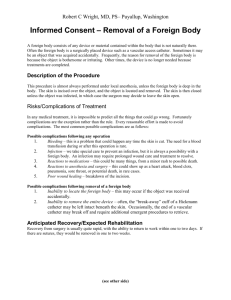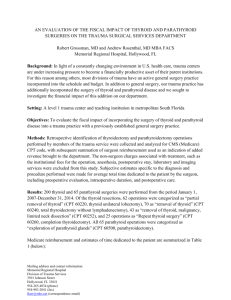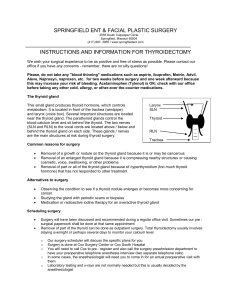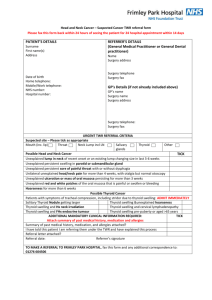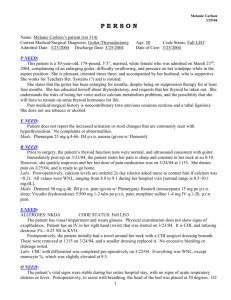Patient information and consent to partial thyroidectomy
advertisement
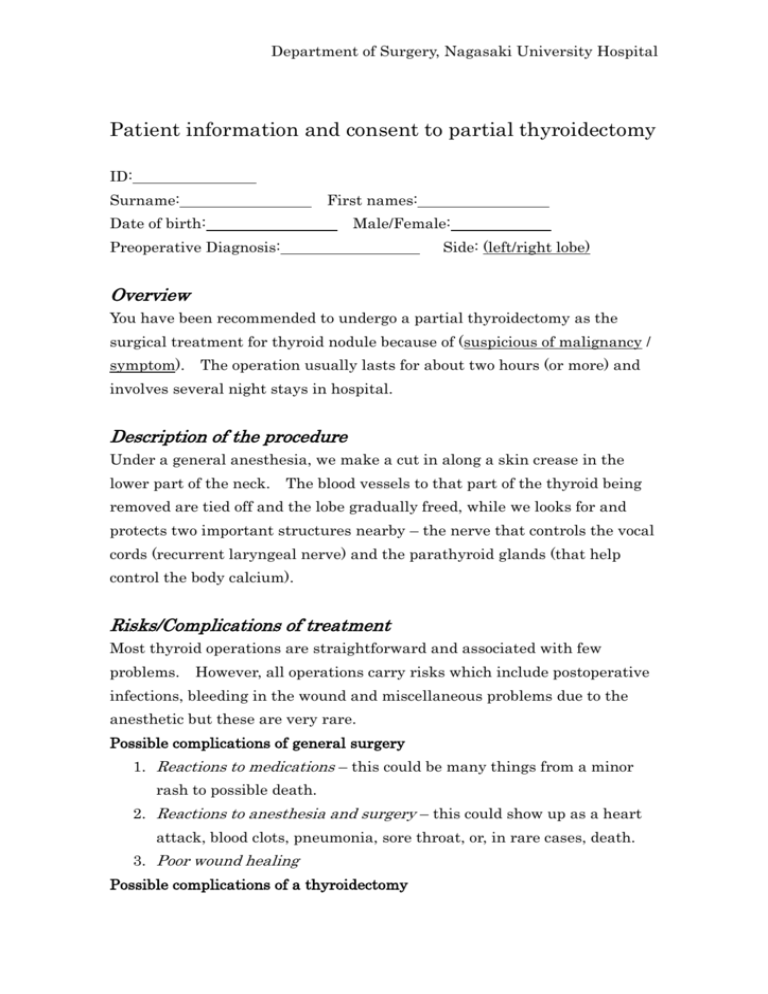
Department of Surgery, Nagasaki University Hospital Patient information and consent to partial thyroidectomy ID: Surname: First names: Date of birth: Male/Female: Preoperative Diagnosis: Side: (left/right lobe) Overview You have been recommended to undergo a partial thyroidectomy as the surgical treatment for thyroid nodule because of (suspicious of malignancy / symptom). The operation usually lasts for about two hours (or more) and involves several night stays in hospital. Description of the procedure Under a general anesthesia, we make a cut in along a skin crease in the lower part of the neck. The blood vessels to that part of the thyroid being removed are tied off and the lobe gradually freed, while we looks for and protects two important structures nearby – the nerve that controls the vocal cords (recurrent laryngeal nerve) and the parathyroid glands (that help control the body calcium). Risks/Complications of treatment Most thyroid operations are straightforward and associated with few problems. However, all operations carry risks which include postoperative infections, bleeding in the wound and miscellaneous problems due to the anesthetic but these are very rare. Possible complications of general surgery 1. Reactions to medications – this could be many things from a minor rash to possible death. 2. Reactions to anesthesia and surgery – this could show up as a heart attack, blood clots, pneumonia, sore throat, or, in rare cases, death. 3. Poor wound healing Possible complications of a thyroidectomy Department of Surgery, Nagasaki University Hospital 1. Voice change – a specific problem related to thyroid surgery is injury to one or both of the recurrent laryngeal nerves. These nerves pass close to the thyroid gland and control movement of the vocal cords. Injury to these nerves causes hoarseness and/or weakness of the voice. It is quite common for the nerve not to work properly immediately after thyroid surgery; this is due to bruising of the nerve. usually recovers over a few days or weeks. Your voice Careful surgery reduces the risk of permanent accidental injury to these nerves a very low level but cannot eliminate the risk completely. 2. Bleeding – this is a problem that occasionally may require the second operation. 3. Infection 4. Low blood calcium levels – the parathyroid glands or their blood supply may be damaged. This is rarely a problem if the operation is only on one side as most people have two glands on each side, and the glands on the other side can usually cope. 5. Seroma formation – this is a collection of fluid beneath the wound. After the procedure ・ After the operation, you will be able to drink when you are fully awake again. This usually takes six hours. Meal will be served on the first days. ・ The drains will usually be removed in a couple of days. ・ The time that you stay in hospital will depend on how you are feeling after your operation and your doctor's opinion. ・ You will be given a date to return to clinic for the results of your surgery. By then the tissues removed at the operation will have examined and your results discussed by clinicians. Any further treatment, if recommended, will be discussed with you then. Department of Surgery, Nagasaki University Hospital Consent for Treatment I understand my condition to be thyroid nodule. I have read and understand the above explanation of the procedure being proposed. My surgeon has answered my questions, and I choose to proceed with surgery. I understand that every operation may yield unexpected finding. I give the surgeon permission to act on his best judgment in deciding to remove tissues that appear to be diseased, understanding that complications may arise from that action. Print Name of Patient __________________________________________________________________ Signature __________________________________________________________ Date _________________ Witness ____________________________________________________________ Date _________________ Surgeon ____________________________________________________________ Date _________________ Relationship to Patient if Signature of Legal Guardian ___________________________________





